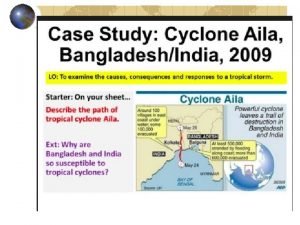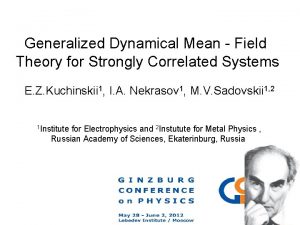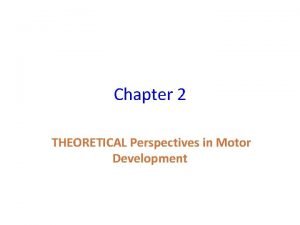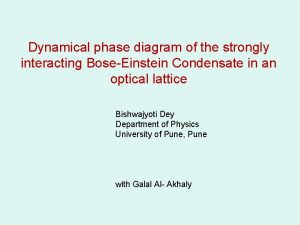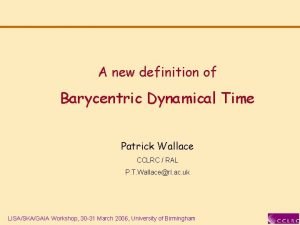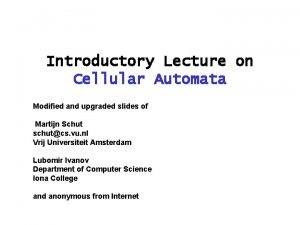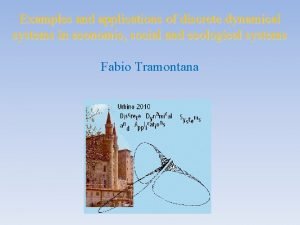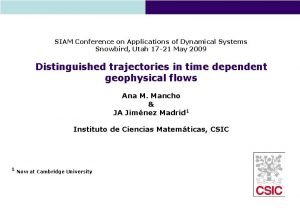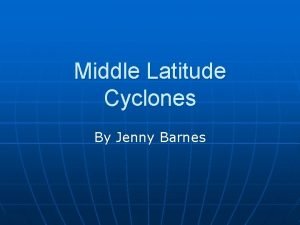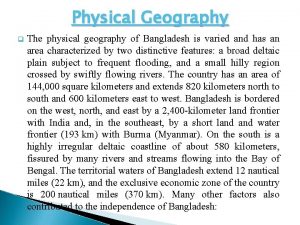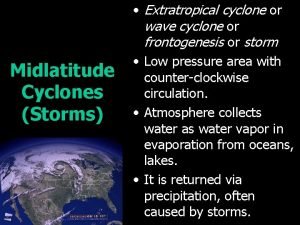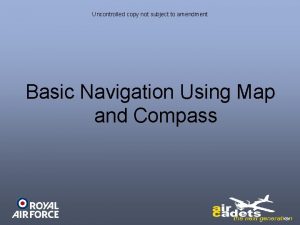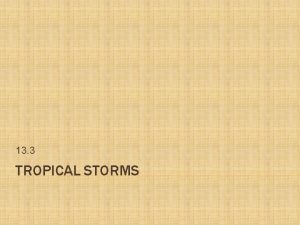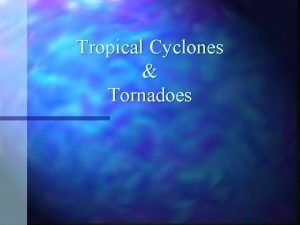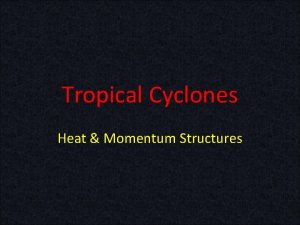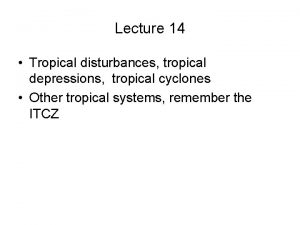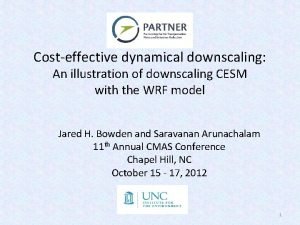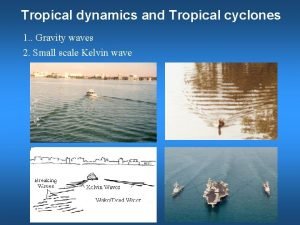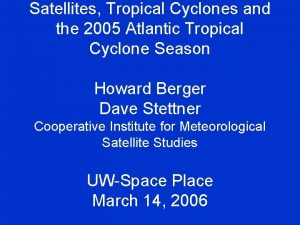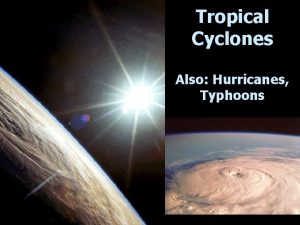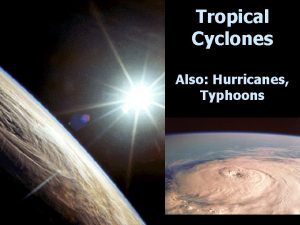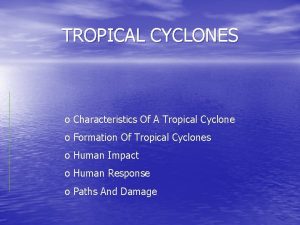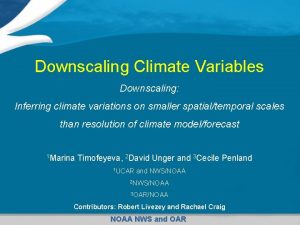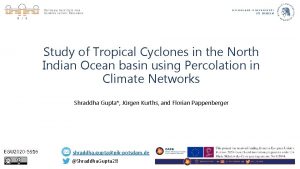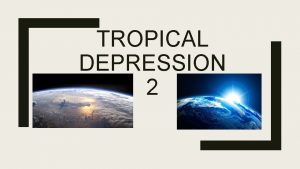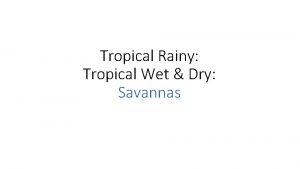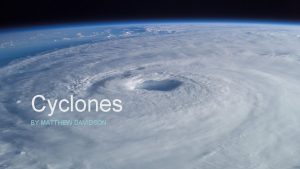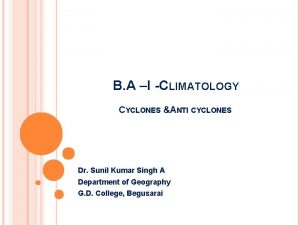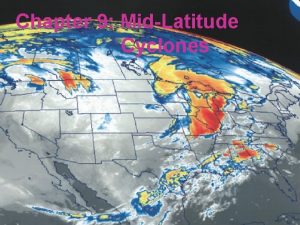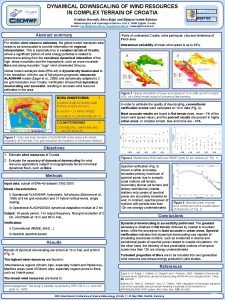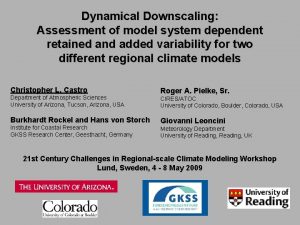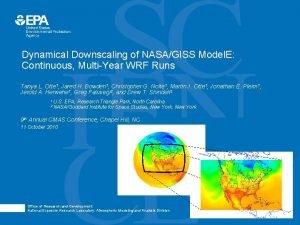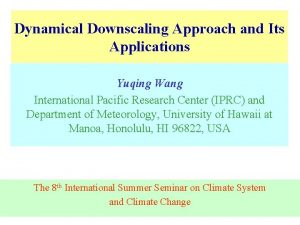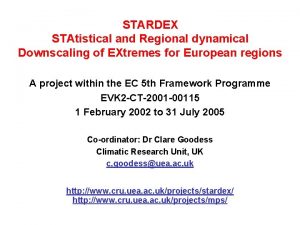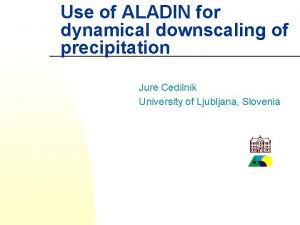Dynamical Downscaling of Tropical Cyclones for the North















































- Slides: 47

Dynamical Downscaling of Tropical Cyclones for the North West Debbie Abbs A. Rafter, K. Nguyen, M. Thatcher Centre for Australian Weather and Climate Research A partnership between CSIRO and the Bureau of Meteorology CSIRO Marine and Atmospheric Research

Outline of talk • Background • ENSO variability in Australian Region (Based on Australian Bureau of Meteorology TC dataset) ENSO years from Kuleshov et al. (2008) • The Conformal Cubic Atmospheric Model (CCAM) • Detection scheme • The model suite • TCs in CCAM forced with Reanalyses • Modelled characteristics of ENSO variability • Modelled trends • TCs in CCAM climate change simulations • Impact on: • • • Numbers, Spatial distribution, Intensity Longevity, Genesis and Decay IOCI 3 – Perth 29 August, 2008

ENSO Variability & TCs in the Australian Region (1) Average annual distribution of TCs (TC/year) Impact of ENSO on genesis location (El Nino – La Nina) (TC/year) TCs form further south in La Nina years IOCI 3 – Perth 29 August, 2008

ENSO Variability & TCs in the Australian Region (2) • Kuleshov et al. (2008) note significant correlations between seasonal TC numbers and ENSO indices • ENSO also affects region of occurrence Impact of ENSO on occurrence (El Nino – La Nina) (TCs/year) TCs occur closer to the coast in La Nina years IOCI 3 – Perth 29 August, 2008

Introduction • Purpose of the work • Examine potential changes in TC behavior in the Australian region associated with climate change • Model-based approach: • Resolution issues: almost all GCMs unable to produce reliable TCLVs (Tropical Cyclone-Like Vortices) at native resolution (~200 km) • Method: • GCM output downscaled to ~60 km over Australia (to ~100 km in surrounding area) using a stretched-grid global atmospheric model • TCLV detection scheme to find TCs in model output • Examine how well model represents existing TC climate • Analyse impact of climate change • Downscale most intense TCLVs to 15 km resolution in regional model changes in intensity (& rainfall) IOCI 3 – Perth 29 August, 2008

The Conformal Cubic Atmospheric Model (CCAM) 100 km 65 km spacing Maps the Earth onto a cube. Highest resolution on ‘face’ over Aust – very coarse on opposite side. IOCI 3 – Perth 29 August, 2008

Detection of TCLVs in CCAM using modified Walsh detection criteria • a vorticity more negative than -10 -5 s-1 (as cyclonic vorticity is negative in the Southern Hemisphere); • a closed pressure minimum, taken to be the centre of the storm, within 250 km from a point satisfying criterion 1; • the total tropospheric temperature anomalies at 750, 500 and 300 h. Pa must be greater than zero, signifying that the storm has a warm core; • the mean wind speed in the area 500 km × 500 km around the centre of the storm at 850 h. Pa must be higher than that at 300 h. Pa; • the temperature anomaly at 300 h. Pa must be at least 0. 6°K; • the maximum 10 m wind speed in the storm at any one time must be at least 11. 5 ms-1; • there must be rotation, as defined by the wind direction, around the storm centre; • genesis can only over the ocean and; • SST ≥ 26°C IOCI 3 – Perth 29 August, 2008

The Model Suite • An opportunistic approach – runs weren’t for TC research • Model testing & development • Regional climate studies • A suite of 4 simulations (and growing) nested in reanalyses • • Does the model adequately represent reality? NCEP and ERA 40, Different nudging options Different parameterisations schemes • A single (but growing number of) climate change simulation • • Nested in CSIRO Mk 3 A 2 simulation Bias-corrected SST Used to identify climate change impact Provide initial and boundary conditions for downscaled runs IOCI 3 – Perth 29 August, 2008

How well does the model represent reality? Reanalysis-based results IOCI 3 – Perth 29 August, 2008

ENSO variability and TCs in CCAM (1) Not enough TCLVs in CCAM ~ 60% of obs Occurrence Spatial characteristics of ENSO on occurrence and genesis captured but too weak – especially for genesis. IOCI 3 – Perth 29 August, 2008 Genesis

ENSO variability and TCs in CCAM (2) CCAM captures variation in TC longitude crossings between El Nino & La Nina years CCAM does not capture the observed inter-annual variability of TC numbers in the Aust. region IOCI 3 – Perth 29 August, 2008

Possible trends in the number of most intense (Cat 4&5) TCs – models as a proxy for reality Harper & Callaghan, 2006 (Cat 3 – 5) This study ( Cat 4 & 5) 1974 -1988 29% 11. 5% 1989 -1998 41% 18. 5% 42% increase 60% increase Change IOCI 3 – Perth 29 August, 2008

What is the impact of climate change? Dynamical downscaling from a GCM IOCI 3 – Perth 29 August, 2008

Tropical Cyclones in CCAM Observations Modelled current climate Cyclone days per year based on an analysis on a 2 x 2 deg grid A similar analysis of TCLVs for the 2030 (2010 -2050) and 2070 (2050 -2090) climates shows a decrease in the total number of storm occurrences by approximately 13. 5% for 2030 and 30. 5% in 2070. IOCI 3 – Perth 29 August, 2008

Where are the decreases? Increased TC activity off Qld More TC days due to longer-lived TCs 2030 Decreased TC activity off WA 2070 IOCI 3 – Perth 29 August, 2008

Duration and Extent Duration Aust Indian Pacific IOCI 3 – Perth 29 August, 2008 Genesis Decay

Summary • ENSO has significant impact on Australian region TCs • CCAM captures spatial variability but not occurrence • Model outputs suggest possible increase in number of intense TCs since 1970 s • Decrease in the number of TC days in the Australian region • Decrease in Indian region – 44% decrease in TC numbers • Increase in parts of Pacific region – 9% decrease in TC numbers • More intense TCs in future • Lower central pressures • Stronger winds – mainly in the Pacific • Changes in TCs duration • Decrease in number of long-lived TCs in Indian • Increase in number of long-lived TCs in Pacific • Increase in poleward occurrence • Poleward shift in latitude of average genesis region • Pacific storms tending to decay further south – average of 3 deg. Latitude. • No change in decay region of Indian storms IOCI 3 – Perth 29 August, 2008

CCAM TCLV detection results: TC numbers and trends • Fewer storms, less variability • Decrease in annual average TC numbers • Also a decrease in the interannual variability as measured by the standard deviation IOCI 3 – Perth 29 August, 2008 current 2030 2070 Mean 16. 0 14. 0 11. 6 Standard deviation 5. 7 5. 0 4. 2

CCAM TCLV detection results: TC numbers and trends • Fewer storms, less variability • Decrease in annual average TC numbers • Also a decrease in the interannual variability as measured by the standard deviation IOCI 3 – Perth 29 August, 2008 current 2030 2070 Mean 16. 0 14. 0 11. 6 Standard deviation 5. 7 5. 0 4. 2 BUT…

CCAM TCLV detection results: Severe TC numbers and trends • More severe TCs! • Increase in annual average intense TC numbers • Also an increase in the interannual variability of intense TCs IOCI 3 – Perth 29 August, 2008 current 2030 2070 Mean 4. 1 8. 7 9. 7 Standard deviation 2. 2 3. 6 3. 7 Indian Ocean Intense TCs 33% 67% 88%

CCAM TCLV detection results: Regional changes - landfall • Fewer landfalls in WA; slightly more in QLD • Average annual latitude crossings – proxy for landfall • Fewer crossings seen in NW WA region • Slightly more crossings off QLD IOCI 3 – Perth 29 August, 2008

CCAM TCLV detection results: Regional changes – TC threat • TCs within 300 km of location (40 year time slices) • Large decrease in activity near Port Headland • Fewer storms but longer lasting around Cairns Port Hedland Number of TCs TC days Cairns Number of TCs TC days Obs 55 78 Obs 41 62 current 37 54 current 46 60 2030 31 35 2030 36 57 2070 23 30 2070 31 59 Number of TCs TC days Mackay Number of TCs TC days Obs 19 23 26 current 6 8 47 2030 6 9 2070 9 12 Obs 26 33 current 22 41 2030 18 2070 30 IOCI 3 – Perth 29 August, 2008 Brisbane

CCAM TCLV detection results: Changes in decay location • More storms decaying off the WA coast instead of over land • TCs off QLD seem to be decaying further south (main driver for increases seen in Cairns, Mackay and Brisbane for 2070) Current climate decay locations IOCI 3 – Perth 29 August, 2008 Changes in decay location - 2070

Continental scale to Regional scale: RAMS • Regional Atmospheric Modeling Scheme – a high resolution nonhydrostatic model • 2 -way nested grid (45 km and 15 km for these experiments) • Relocatable – different domain required for each individual storm modelled • Event selection for downscaling • 100 “deepest” storms from three 40 -year CCAM climatologies: • “current”– 1961 -2000 • “ 2030” – 2011 -2050 • “ 2070” – 2051 -2090 • Further downscaling to 5 km for most-intense phase of storm • Use 15 km outputs • Downscale ~60 hours at most intense phase IOCI 3 – Perth 29 August, 2008

Setup of RAMS simulations • Initialising RAMS • Initialised with CCAM model output from 24 hours prior to first detection (i. e. genesis) in CCAM • CCAM output also used for boundary conditions of grid • TC bogus inserted for first TC detection at 24 hour into RAMS simulation • Bogus vortex initialised using minimum central pressure 5 h. Pa deeper than CCAM pressure, radius to maximum wind of 50 km and radius of outer closed isobar of 250 km. • Strong nudging for first 24 hours to TC bogus central pressure for TC spin-up. Weak nudging for remainder of the simulation. IOCI 3 – Perth 29 August, 2008

RAMS downscaling results: Minimum track pressure • Obvious shift • Distinct shift to deeper pressures in 2070; less clear in 2030 but still present • Pressures still not realistically low IOCI 3 – Perth 29 August, 2008

RAMS downscaling results: Maximum wind speed • Not as clear • Little change from current to 2030 • Shift in PDF by 2070 IOCI 3 – Perth 29 August, 2008

Summary • Deeper central pressures; less clear impact on wind speeds • Shift toward deeper pressure storms • Maximum wind speed does not strongly follow this result • Fewer storms in total but more frequent severe TCs • Higher proportion of TCs will be severe, long-lasting storms • Fewer TC landfalls in WA; slight increase in QLD • Fewer longitudinal crossings (landfall proxy) in WA region; slightly more crossings in QLD region • More TC activity off QLD; less activity off WA • Fewer TC days off Port Headland; more TC days for Cairns, Mackay and Brisbane by 2070 • TCs decaying further to the south off QLD; further north off WA IOCI 3 – Perth 29 August, 2008

Debbie Abbs CMAR/CAWCR Phone: (03) 9239 4660 Email: deborah. abbs@csiro. au Thank you Contact Us Phone: 1300 363 400 or +61 3 9545 2176 Email: enquiries@csiro. au Web: www. csiro. au IOCI 3 – Perth 29 August, 2008

Climate change and its impact on extreme rainfall in SE Australia (Abbs & Rafter) IOCI 3 – Perth 29 August, 2008

Background IPCC (AR 4) & rainfall extremes • Intensity of rainfall events projected to increase. . . even in areas where mean rainfall decreases (longer periods between rainfall events) Chap 10 (Global Climate Projections) • Extremes of daily rainfall very likely to increase, except possibly in areas of significant decrease in mean rainfall (southern Australia in winter & spring) Chap 11 (Regional Climate Projections: Australia – New Zealand) Recent & current projects (CSIRO +) • SEQ – NNSW (DCC, Gold Coast City Council) • Central Coast NSW (DCC, UPRCT, Sydney Metro CMA, Sydney Water, Southern Rivers CMA, Hunter-Central Rivers CMA • Vic & lower MDB (DCC, SEACI) • Fitzroy R. catchment (QDNRM) IOCI 3 – Perth 29 August, 2008

Climate Change projections for rainfall in Australia • 1. 2. 3. Projections contain uncertainty due to 3 sources Climate Sensitivity Emissions Uncertainty Spatial Patterns differ amongst different models H G HI MID LOW IOCI 3 – Perth 29 August, 2008

Model Uncertainty – the answer depends on the model ARI-100 changes for 2070 from 5 CSIRO climate models D 125 CC-Mk 3 CC-Mk 2 -rx 1 IOCI 3 – Perth 29 August, 2008 Mk 3 -UK 2

Median ARI-5 and ARI-100 change for 2070 from 5 climate models Most models agree on increase Agreement on the direction of change from 25 events Most models agree on decrease IOCI 3 – Perth 29 August, 2008

Global & Regional Climate Models • • • GCMs & RCMs do a good job at simulating global statistics of temperature-related extremes. GCMs produce too many days with weak rainfall & too little rainfall in extreme events. GCMs & RCMs have coarse spatial resolution & use parameterizations for unresolved process important for rainfall (e. g. cloud formation, deep convection). Not all GCMs & RCMs skilfully simulate the weather that produces extreme rainfall. IPCC TAR (2001) recommends improvements to ‘integrated hierarchy’ of GCMs & RCMs IOCI 3 – Perth 29 August, 2008

200 km Dynamical Downscaling • Far more realistic representation of coastal & terrain effects • Improved representation of weather events (e. g. fronts, TCs, cut-off lows) 65 km 4 km IOCI 3 – Perth 29 August, 2008 • Better simulation of ingredients of extreme events (wind, moisture, ascent) • Assumes host GCM represents observed statistical characteristics of main rainfall producing systems (circulation & moisture variables)

Value Added by Dynamical Downscaling Average fractional change in intensity of extreme rainfall for events of approximately ARI-4 to 40 years 200 km 65 km 4 km 2030 2070 Decrease in intensity IOCI 3 – Perth 29 August, 2008 Large increases in intensity fraction

Weather systems causing extreme rainfall in Wollongong – Newcastle region 1 17% IOCI 3 – Perth 29 August, 2008 2&4 2 10% 3 3 24% 5 18%

How well do the models do? CSIRO GCM CCAM Regional IOCI 3 – Perth 29 August, 2008

Impact on Hi-Res Downscaling – 1 -in-100 year events 24 hr rainfall change for 2070 R-CC-Mk 2 R-CC-Uk 2 R-CC-M 20 Challenge: How do we synthesise results to provide meaningful products for hydrological applications? IOCI 3 – Perth 29 August, 2008

1 -in-100 year rainfall events AR&R (1987, 1997) Ensemble Average (a) IOCI 3 – Perth 29 August, 2008 (b)

“Consensus” 2070 ARI-100 2070 Projected changes for 2070 IOCI 3 – Perth 29 August, 2008

Products from dynamical downscaling – 30 min to 96 hours, ARI-1 to 100 years Return period curves Depth-area curves Temporal curves IFD curves IOCI 3 – Perth 29 August, 2008

Applications: Impact of Climate Change on Flooding Case Study for Nerang Catchment Based on single member projection. • Currently 4500 properties are flood prone - $140 M damages • 20% increase in rainfall → 7000 properties - $235 M IOCI 3 – Perth 29 August, 2008

Development of PDFs from Ensemble Members Projected changes for 24 -hr 1 -in 100 year events – Warragamba Catchment Percentage change R-CC-Mk 2 R-CC-M 20 IOCI 3 – Perth 29 August, 2008 R-CC-UK 2 Ens. Av. Minimum -49. 4 10% -17. 2 25% 7. 0 Median: 8. 3 Mean 16. 1 75% 34. 7 90% 61. 6 Max 161. 0

Summary Climate change has major implications for the risks posed by severe weather events. This will be exacerbated by the impacts of population growth, especially along the east coast of Australia. • Extreme rainfall is likely to increase in many regions, especially mountainous regions (SEQ, Sydney Region studies). • Local interaction of weather with topography important • Impact greatest for the 2 -hr rainfall accumulations & less for the longer durations. • Extreme rainfall occurring in heavier bursts. • Tendency for rainfall to begin earlier in 72 -hr events • Impact increases with time – greater at 2070 • PDF’s of changes in rainfall intensity, temporal pattern from downscaled simulations can be used to perturb historic events to investigate changes in flood risk • Outputs are now being used for planning by/for: Glenelg-Hopkins Catchment Auth. Gold Coast City Council Melbourne Water SEQ Regional Plan NICCARA IOCI 3 – Perth 29 August, 2008

The Centre for Australian Weather and Climate Research A partnership between CSIRO and the Bureau of Meteorology Debbie Abbs Phone: (03) 9239 4660 Email: Deborah. Abbs@csiro. au Web: www. cawcr. gov. au Thank you IOCI 3 – Perth 29 August, 2008
 Describe the global distribution of tropical storms
Describe the global distribution of tropical storms Dynamical mean-field theory
Dynamical mean-field theory Motor learning theories
Motor learning theories Solution in search of a problem
Solution in search of a problem Repeat
Repeat Dynamical systems examples
Dynamical systems examples Accelarationist
Accelarationist Siam conference on applications of dynamical systems
Siam conference on applications of dynamical systems Dynamical systems neuroscience
Dynamical systems neuroscience Mt air mass
Mt air mass What are middle latitude cyclones
What are middle latitude cyclones Physical geography of bangladesh
Physical geography of bangladesh Mid latitude cyclone characteristics
Mid latitude cyclone characteristics True north vs magnetic north
True north vs magnetic north Chapter 14 north and south
Chapter 14 north and south North east and cumbria ics
North east and cumbria ics The north pole ____ a latitude of 90 degrees north
The north pole ____ a latitude of 90 degrees north Redogör för vad psykologi är
Redogör för vad psykologi är Geometri för barn
Geometri för barn Bästa kameran för astrofoto
Bästa kameran för astrofoto Lyrik
Lyrik Etik och ledarskap etisk kod för chefer
Etik och ledarskap etisk kod för chefer Publik sektor
Publik sektor Antikt plagg
Antikt plagg Tidbok
Tidbok Kontinuitetshantering
Kontinuitetshantering Vilken grundregel finns det för tronföljden i sverige?
Vilken grundregel finns det för tronföljden i sverige? Bamse för de yngsta
Bamse för de yngsta Ministerstyre för och nackdelar
Ministerstyre för och nackdelar Sju principer för tillitsbaserad styrning
Sju principer för tillitsbaserad styrning Vem räknas som jude
Vem räknas som jude Nyckelkompetenser för livslångt lärande
Nyckelkompetenser för livslångt lärande Ro i rom pax
Ro i rom pax Stig kerman
Stig kerman Shingelfrisyren
Shingelfrisyren Vad är verksamhetsanalys
Vad är verksamhetsanalys Modell för handledningsprocess
Modell för handledningsprocess Borstål, egenskaper
Borstål, egenskaper Verktyg för automatisering av utbetalningar
Verktyg för automatisering av utbetalningar Shivaismen
Shivaismen Centrum för kunskap och säkerhet
Centrum för kunskap och säkerhet Inköpsprocessen steg för steg
Inköpsprocessen steg för steg Expektans
Expektans Lyckans minut erik lindorm analys
Lyckans minut erik lindorm analys Strategi för svensk viltförvaltning
Strategi för svensk viltförvaltning A gastrica
A gastrica Typiska drag för en novell
Typiska drag för en novell Formula varians
Formula varians
